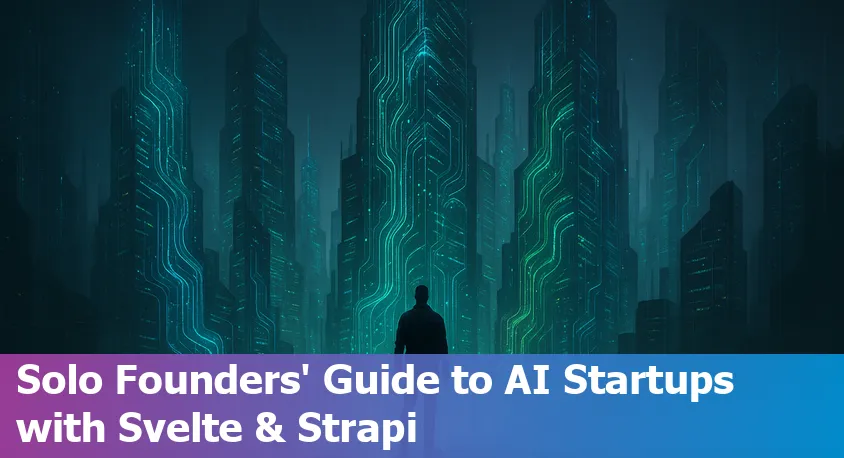Building Scalable AI Startups as a Solo Founder with Svelte and Strapi
Last Updated: June 1st 2025

Too Long; Didn't Read:
In 2024, 38% of bootstrapped startups were led by solo founders leveraging AI for automation and scalability. Using Svelte for rapid frontend development and Strapi as a headless CMS, individuals can quickly launch, validate, and scale AI startups - achieving milestones like $100K ARR and global reach without a full-time team.
The solo founder revolution in AI startups signals a seismic shift in how groundbreaking businesses are built and scaled. Once dependent on large teams and venture capital, solo entrepreneurs now leverage AI-driven automation, cloud-based tools, and lean methodologies to launch, operate, and expand innovative companies entirely on their own.
In 2024, solo founders accounted for 38% of bootstrapped startups, thriving through resourcefulness, relentless focus, and rapid adaptation - qualities amplified by AI's ability to automate workflows, produce actionable insights, and streamline customer interactions.
Learn more about the rise of solo founders in bootstrapped startups in this Moonpreneur article.
This transformation is so profound that industry leaders - including OpenAI's CEO - predict the emergence of billion-dollar one-person companies, enabled by tools that replace tasks once requiring entire departments.
Discover insights on the future of solo AI companies in this Forbes article.
As AI democratizes advanced business functions, even non-technical founders like those highlighted in recent case studies launch and scale from their laptops, prioritizing lean experimentation and strategic automation.
As one leader notes:
“You don't need a full-time staff anymore - just the right problem to solve and the right mix of AI tools and freelancers.”
Explore more on the indispensable role of AI for solo tech entrepreneurs in this guide to building solo tech empires.
Table of Contents
- The Solo Founder's Edge: How AI and Automation Empower Individuals
- Why Choose Svelte and Strapi for Your Tech Stack?
- Blueprint: Building a Scalable AI Startup with Svelte and Strapi
- Inspiring Success Stories: Real Solo AI Founders Who Scaled
- Common Pitfalls and Practical Tips for Sustainable Growth
- Getting Started: Launch Your Own AI Startup Today
- Frequently Asked Questions
Discover how bootstrapping an AI business with no money is possible by leveraging free tools and global resources.
The Solo Founder's Edge: How AI and Automation Empower Individuals
(Up)Solo founders are rapidly redefining the startup landscape, thanks to the transformative power of AI and automation. A recent surge in solo-led ventures reflects a fundamental shift: in 2024, 38% of new US startups had solo founders without VC funding, nearly double the figure from 2015 - a change fueled by accessible AI tools that enable individuals to build faster, automate tasks, and operate with unprecedented efficiency.
Learn more about the Era of Solo Founders and AI.
From generative AI acting as a virtual co-founder to automation platforms streamlining routine work, solo entrepreneurs now have the capacity to innovate and scale with resources once reserved for large teams.
Discover how to Build a Billion-Dollar Company with AI as a Solo Founder.
As Dan Khan noted regarding this changing landscape,
“AI is accelerating this shift, enabling individuals and tiny teams to build products at a scale that used to require dozens (if not hundreds) of people.”
In practical terms, the modern solo founder leverages AI-driven tools to manage everything from product development to customer support, creating opportunities to bootstrap longer, retain more ownership, and achieve impressive revenue per employee.
Explore more on The Future of Building: AI, Solo Founders, and What Comes Next for Startups.
The rise of solo founders empowered by AI demonstrates that, with the right strategy and tools, building and scaling high-growth startups is no longer limited to large, well-funded teams.
Why Choose Svelte and Strapi for Your Tech Stack?
(Up)For solo founders aiming to build scalable AI startups, Svelte and Strapi offer a modern tech stack that maximizes performance and developer efficiency. Svelte is revolutionizing frontend development in 2025 with its build-time compilation model - removing the need for a virtual DOM - which results in smaller JavaScript bundles, lightning-fast load times, and a developer experience that feels like writing pure JavaScript, making it especially beneficial for startups where speed, maintainability, and clarity matter most (why Svelte is revolutionizing frontend development).
Not only does Svelte drastically reduce boilerplate and enable highly reactive interfaces, it also supports both server-side and client-side rendering through SvelteKit, allowing seamless integration of APIs and frontend in one project - a huge advantage for lean teams or solo projects (Svelte web development made simple).
Compared to React and Vue, Svelte stands out for its unmatched performance and smallest JS payload, as highlighted in the following table:
| Framework | Strengths | Performance Characteristics |
|---|---|---|
| Svelte | Smallest JS payload, no virtual DOM diffing | Fastest time-to-hydrate, lean memory usage, very quick first loads |
| Vue | Efficient rendering, smaller bundles | Close second in speed, good for load times |
| React | Mature, large ecosystem | Slightly slower but scales for complex, interactive apps |
This makes Svelte particularly well-suited for startups needing ultra-fast applications, efficient development cycles, and future-ready SEO and scalability practices (comparing front-end frameworks for startups in 2025).
By choosing Svelte and Strapi, solo founders can streamline MVP launches, reduce hosting costs, and deliver exceptional user experiences - key ingredients for startup success in AI.
Blueprint: Building a Scalable AI Startup with Svelte and Strapi
(Up)Building a scalable AI startup as a solo founder is increasingly achievable by leveraging a modern stack like Svelte for frontend development and Strapi as the headless backend.
Svelte offers a streamlined, high-performance approach to user interface creation, while Strapi's component-based architecture and REST/GraphQL APIs enable fast, customizable backend setup with minimal code.
Together, they allow you to rapidly prototype, iterate, and launch your MVP without heavy infrastructure investment. According to best practices, begin by identifying routine, time-consuming tasks that can be automated - AI tools can bolster SEO strategies, generate content, and even automate the transformation of video into publish-ready articles, letting you focus on creativity and strategic growth rather than manual chores.
For robust scalability, adopt cloud infrastructure, use role-based access controls, and consider plugins for caching and analytics.
| Key Steps | Tools & Features |
|---|---|
| Define content models | Strapi Admin Panel, APIs (REST/GraphQL), RBAC |
| Frontend development | Svelte UI components, Tailwind CSS |
| Integrate automation & AI | AI-driven content, SEO boosters |
| Test & deploy | Cloud hosting, CI/CD, plugins |
“Strapi supports omni-channel publishing: content created once can be pushed across websites, mobile apps, and unconventional devices (e.g., refrigerator smart screens) without extra formatting.”
To see real-world application of these concepts and code, review the detailed tutorial on building a task management app with Svelte, Strapi, and Tailwind CSS, and explore automation possibilities for content with AI-powered tools integrated in Strapi.
For deeper deployment and integration strategies that will grow with your business, consult the Strapi Integrations Best Practices guide for practical security and scalability tips tailored to ambitious solo founders.
Inspiring Success Stories: Real Solo AI Founders Who Scaled
(Up)The rise of solo AI founders has ushered in a new era of scalability and innovation, with entrepreneurs independently building impactful, revenue-generating startups across every sector.
For instance, Mustafa Ergisi singlehandedly launched AI2SQL, an AI-based platform that translates plain English into SQL queries, reaching $100K ARR and profitability serving B2B and B2C clients.
Similarly, founders like Bhanu Teja (SiteGPT, a custom chatbot builder) and Samanyou Garg (Writesonic, an AI content assistant) demonstrate that with generative AI, it's feasible to reach $15,000 monthly revenue or grow to millions in ARR without a team, simply by leveraging modern open-source libraries and robust APIs - a trend supported by the fact that 36% of founders in 2024 operated solo, double from just a few years prior (The Solo AI Founder report).
These success stories are not limited to tech alone; in highly regulated sectors like healthcare, solo founders are creating breakthrough AI startups that solve complex challenges in diagnostics, monitoring, and compliance, and are scaling globally by applying capital-efficient strategies and automations (AI HealthTech Startup Case Studies).
The table below showcases standout solo founder achievements:
| Startup | Founder | Product | Key Metric |
|---|---|---|---|
| AI2SQL | Mustafa Ergisi | AI-driven SQL from English | $100K ARR |
| SiteGPT | Bhanu Teja | Custom chatbot builder | $15K/month revenue |
| Writesonic | Samanyou Garg | AI content assistant | Millions in ARR |
These examples demonstrate the growing opportunity: generative AI models and open-source libraries have become powerful and accessible, enabling single developers to create impactful AI-powered SaaS products independently.
By harnessing modern frameworks like Svelte and Strapi alongside best-in-class AI APIs, solo founders can scale innovation, validate ideas rapidly, and turn their technical vision into thriving global businesses.
Common Pitfalls and Practical Tips for Sustainable Growth
(Up)Scaling an AI startup as a solo founder comes with unique hurdles, from decision fatigue to market missteps, but proven strategies can promote sustainable growth and resilience.
One common pitfall is falling into confirmation bias and isolation, as highlighted by Alex Cook, who warned that,
“GPT is an ego's best friend. Every question I asked to explore my plan was met with a congratulatory tone,”
cautioning that AI support should not replace the value of human collaboration and outside feedback.
Solo founders often struggle with indecision and analysis paralysis, but progress accelerates when you adopt systematic frameworks and make results visible, overcoming these decision-making bottlenecks by following actionable insights for solo founders.
Furthermore, sustainable lead generation requires diversifying channels and consistent nurturing, as relying on just one approach is risky; creative landing pages, focused offers, explainer videos, and trust-building testimonials can substantially improve conversion rates according to these 10 strategies for startup growth.
Lastly, to avoid the classic mistakes outlined by Y Combinator - like building without user feedback or delaying launches - solo founders should balance rapid iteration with validation and always put users first.
For a clear overview, consider these key pitfalls and remedies:
| Pitfall | Practical Tip |
|---|---|
| Confirmation Bias | Actively seek critical feedback, both from users and peers. |
| Analysis Paralysis | Use frameworks to systematize decision-making and show quick progress. |
| Lead Generation Reliance | Diversify acquisition channels and regularly refresh marketing strategies. |
By embracing community input, methodical growth strategies, and a user-obsessed mentality, solo AI founders can sidestep the most common stumbling blocks and build for long-term success.
For more, see this in-depth analysis of the top mistakes that kill startups and how to avoid them.
Getting Started: Launch Your Own AI Startup Today
(Up)Ready to turn your solo founder ambitions into a scalable AI startup? Start by applying lean MVP principles - focus on building only the critical features to deliver value and validate your idea rapidly, as outlined in Nucamp's guide to innovating with limited resources.
Harness the speed and efficiency of Svelte and Strapi for rapid prototyping: Svelte compiles to highly-performant JavaScript with minimal code, while Strapi provides an intuitive, open-source headless CMS for instantly creating customizable REST or GraphQL APIs with robust access controls, as detailed in Strapi's Svelte CMS integration overview.
For solo founders aiming to implement AI features and scale globally, it's crucial to choose the right technology platform early and leverage automation, workflow tools, and cloud hosting - actionable techniques are available in Nucamp's AI startup platform selection guide.
If you want structured support as you launch, Nucamp's 30-week Solo AI Tech Entrepreneur bootcamp offers step-by-step instruction, practical projects, and mentorship at an accessible monthly price, positioning you to succeed from ideation to global growth.
Your next step: pick your tools, validate your idea, and iterate fast. The solo founder revolution in AI begins with taking the first step today.
Frequently Asked Questions
(Up)How are solo founders leveraging AI to build and scale startups in 2024?
Solo founders are using AI automation, cloud-based tools, and lean methodologies to launch and operate innovative startups entirely on their own. In 2024, 38% of bootstrapped startups were led by solo founders, who use AI for automating workflows, generating insights, and streamlining customer interactions, allowing them to scale quickly and efficiently without large teams.
Why choose Svelte and Strapi as a tech stack for solo AI founders?
Svelte and Strapi offer a high-performance, modern development stack that maximizes efficiency for solo founders. Svelte reduces JavaScript bundle size and improves load times through its build-time compilation model, while Strapi enables fast backend setup using REST or GraphQL APIs. This combination allows solo founders to prototype, launch, and scale AI products rapidly - with minimal code and infrastructure costs.
What are the key steps to building a scalable AI startup as a solo founder using Svelte and Strapi?
Start by defining your content models in Strapi and building a responsive frontend with Svelte. Integrate AI for automation and content generation, and utilize cloud hosting for easy deployment. Use plugins for analytics and caching, and focus on rapid prototyping and iteration to achieve scalability with minimal resources.
Are there real-world examples of solo founders who have succeeded with this approach?
Yes, several solo founders have built successful AI startups. Notable examples include Mustafa Ergisi, founder of AI2SQL ($100K ARR), Bhanu Teja of SiteGPT ($15,000/month revenue), and Samanyou Garg of Writesonic (millions in ARR). These founders leveraged AI, open-source frameworks, and lean methodologies to launch and scale their businesses independently.
What are common challenges for solo founders in AI startups and how can they be overcome?
Common pitfalls include confirmation bias, decision fatigue, and over-reliance on single lead-generation channels. These can be overcome by seeking outside feedback, using systematic decision-making frameworks, diversifying marketing efforts, and maintaining a user-centric approach throughout product development.
Learn how meeting investor-ready compliance essentials can dramatically boost your fundraising prospects across 150 countries.
See how code refactoring with local AI gives founders maximum privacy and efficiency in their workflows.
Get actionable tips for optimizing for local currency conversion to boost your checkout rates and minimize payment friction.
Amplify your productivity by tapping into automation tools for solo startups that streamline support, onboarding, and operations.
Lay the groundwork for seamless expansion with strong internationalization (i18n) foundations before diving into multi-language localization.
Stay on top of your regulatory and contractual responsibilities using obligation management with AI to track agreements effortlessly.
Get strategic about defining your chatbot's unique role within your solo startup to maximize its effectiveness.
Explore how automated content generation can help solo founders deliver fresh, customized messages without the extra workload.
Ludo Fourrage
Founder and CEO
Ludovic (Ludo) Fourrage is an education industry veteran, named in 2017 as a Learning Technology Leader by Training Magazine. Before founding Nucamp, Ludo spent 18 years at Microsoft where he led innovation in the learning space. As the Senior Director of Digital Learning at this same company, Ludo led the development of the first of its kind 'YouTube for the Enterprise'. More recently, he delivered one of the most successful Corporate MOOC programs in partnership with top business schools and consulting organizations, i.e. INSEAD, Wharton, London Business School, and Accenture, to name a few. With the belief that the right education for everyone is an achievable goal, Ludo leads the nucamp team in the quest to make quality education accessible


